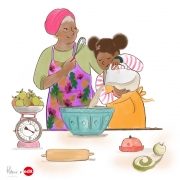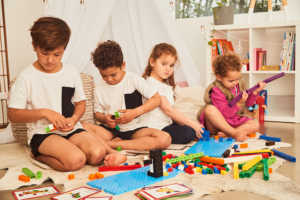Mindfulness – 5 tips for children
Being aware of our emotions and understanding how our emotions manifest in our bodies isn’t always something that comes naturally to us. The good news is that the practice of mindfulness encourages us to recognise our emotions to the point where we can take better control over certain feelings and behaviours. Through simple, mindful activities we can tune into ourselves and begin to take note of our senses and emotions, more so than ever before.
Mindfulness doesn’t have start in adulthood. Children from an early age can benefit from mindfulness and it doesn’t have to be complicated. Emotions can be confusing and overwhelming for both children and adults alike. Mindfulness has been proven to help children have more control over negative emotions, stay focused and pay attention for longer periods of time and make better decisions. While the benefits of mindfulness is impactful and long-lasting for many families, the journey to establishing mindfulness into your household can be smooth with no added pressure.
Before we get started, it’s important to remember that while we can teach our kids to be more mindful, mindfulness isn’t there to stop kids from being kids. Whining, moaning, crying, tantrums – this is all ‘normal kid stuff’. Mindfulness is there to give us all a bit more awareness. Our feelings are feelings and our thoughts are simply ‘just thoughts’ and we are all capable and deserve to shift our mindset to feel calmer and happier.
Here we look at 5 ways you can teach your kids to be more mindful and demonstrate just how easy it is to sprinkle mindfulness into your everyday life…
Walking
Let’s start with something very simple. A way to make your daily walks more interesting and ultimately, more mindful is to simply, notice. Notice the birds and the trees. How do they sound? How far away are they? Can you hear people talking? What other noises can you hear? What else can you see? These prompts allow children to be extra present on their walk, and you too. Paying attention and noticing things you might not usually, helps to calm the mind and direct you into the present which is key for staying mindful. Children will love this new game and it can be done whenever or wherever you are walking to!
Mindful Listening
A fun and easy way for you to get children practicing mindfulness is through sounds. Take any musical instrument toys you have at home or a soundtrack of interesting sounds on a phone app and encourage your child to simply listen. Channeling their focus on specific sounds can be a great, calming activity. After the activity, you can ask your child questions about what they listened to, what they thought of it, and what it made them feel like. Whether you’re playing the radio at home or even in the car, you can incorporate this simple practice through everyday sounds.
Mindful Eating
In the same way that you focus on sounds, do the same during meal times. Mindful eating is a way to engage children’s senses. Encourage them to take note of the look of their food, what it smells like, what it tastes like, what it feels like, and what sound it makes as they bite! This should lead to more calmer meal times, will be great for digestion as they’ll be seated at the table for slightly longer, and will engage the five senses – which is great for mindfulness.
Practicing Gratitude
Being thankful for what we have in our lives can lead us to feel more accepting when things don’t always go our way. This is super important for children. When children get upset about not getting what they want, if something isn’t as quick as they might like it to be, or if they simply cannot have something, they may find it hard to control their emotions. Practicing gratitude with three simple things will be a good place to start.
This could be anything from their comfortable bed with their favourite character bed sheets, for having a sibling, for their friends at nursery/or school – anything that they love! Encouraging your child to speak about three things they are grateful for can lead to more abundance for their lives which in-turn can decrease the negative emotion when things don’t quite go their way. You could even try deflecting the situation to what they are happy about and grateful for when they are feeling upset about something. This wouldn’t be to disregard their feelings, just to simply shift their mind onto something else.
Kids Yoga
As we have all been spending a lot more time at home in recent months, to get our children moving, Yoga is becoming a popular choice for families. There is a huge variety of free Yoga to access from platforms like YouTube and can be a great way to introduce mindfulness to children. Kids Yoga is a fun and physical activity, while teaching children to be more aware of their body and mind. Breathing exercises will help to teach children self-control and essentially help to achieve more of a calming and relaxing state of mind.
Playing, having fun and simply being in the present moment can lead to mindfulness for both ourselves and our children. Being consistent will allow mindfulness to flow more naturally into your household. Allowing it to become part of your everyday dialogue and a main contender in your activities will lead to calmer and more positive days ahead which is a win win for everyone at home! Enjoy!
A new – and growing – collection of digital materials are available online to support new ranges read the ‘Play blog’ on the website, listen to the podcast, see the games and videos and make use of the free downloadable resources for home learning in the teachers/parents section. Head over to www.edxeducation.com even sign up the monthly newsletter.

 EDX Education
EDX Education

 EDX Education
EDX Education Edx Education
Edx Education